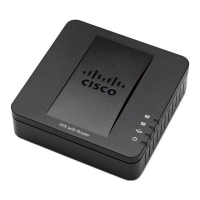In-House Preprovisioning and Provisioning Servers
Provisioning Server Setup
Provisioning Guide for Cisco SPA100 and SPA200 Series Analog Telephone Adapters 40
3
Provisioning Server Setup
This section describes setup requirements for provisioning an ATA by using
various servers and different scenarios. For testing purposes and for the purposes
of this document, provisioning servers are installed and run on a local PC. Also,
generally available software tools are useful for provisioning these ATAs.
TFTP Provisioning
These ATAs support TFTP for both provisioning resync and firmware upgrade
operations. When devices are deployed remotely, HTTP is recommended for
provisioning as it offers greater reliability, given NAT and router protection
mechanisms. TFTP is useful for the in-house preprovisioning of a large number of
un-provisioned devices. See In-House Device Preprovisioning, page 39 for more
information.
The ATA is able to obtain a TFTP server IP address directly from the DHCP server
through DHCP option 66. If a Profile_Rule is configured with the filepath of that
TFTP server, the device downloads its profile from the TFTP server when it is
connected to a LAN and powered up.
The Profile_Rule provided with the factory default configuration is /device.cfg. For
example, on a SPA962 the filename is spa962.cfg. If the device has the factory
default profile, when powered up it resyncs to this file on the local TFTP server
specified by DHCP option 66. (The filepath is relative to the TFTP server virtual
root directory.)
Remote Endpoint Control and NAT
The ATA accesses the Internet through a router by using network address
translation (NAT). For enhanced security, the router might attempt to block
unauthorized incoming packets by implementing symmetric NAT (a packet filtering
strategy that severely restricts the packets that are allowed to enter the protected
network from the Internet). For this reason, remote provisioning by using TFTP is
not recommended.

